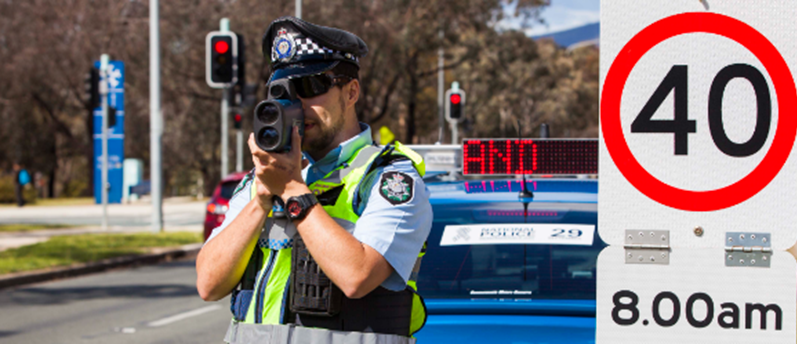Speeding and other Traffic Offences
SPEEDING 1
DON’T COMPROMISE YOUR DEFENCE
Let’s assume that on a lovely sunny day you’re out riding or driving when you’re pulled over by a police vehicle. The officer approaches you and introduces him/herself. The officer advises you that you were speeding, which may or may not come as a surprise to you.
The first thing to understand, is that if it is a highway patrol vehicle the conversation is being recorded - both audio and video. Often people are nervous and say things they later wish they hadn’t. Even if it is not a highway patrol vehicle, the officer will have body cam or make notes as to what responses you may have made. It is safer not to make any admissions, especially if you do not have all the facts and preferably not even then, because doing so may seriously compromise your potential defence.
For example, where exactly do they say they observed you speeding? How did they assess your speed? It can be the case that where you were alleged to be speeding is not where you have been pulled over by police, and you may not have been speeding at the point they say you were.
For example, in the Southern Highlands I defended a case where after viewing the ICV it was clear the bike passed the unmarked police car travelling in the opposite direction some 15 kilometres from where the rider was eventually pulled up. Accordingly the rider had no idea what the officer was talking about.
Generally, there are four methods by which police assess speed (for the moment excluding fixed and mobile speed cameras), listed here in descending order of accuracy:
1 The Lidar -a gun like object which projects a laser beam and is aimed by the officer at an alleged specific target.
2 The in-car radar - a radar attached to the police car and usually operates by way of a Doppler beam.
3 The check speed - a police officer follows you assessing your speed by using the digital speedometer in their car, which essentially shows their speed and may not be yours.
4 Police officers estimate -based on the evidence a police officer will give, stating that in his/her opinion you were travelling at a certain speed. There is often no objective measurement of your speed in this instance.
Often the police will use one of the first 3 methods combined with their estimate.
THINGS TO CONSIDER WHEN YOU’RE PULLED OVER
1. If you have the presence of mind, one should ask the officer where you were alleged to have been speeding when they assessed your speed.
2. Take photographs with your phone of where the incident is meant to have taken place
3. If you have the capacity on your sat nav or phone, log the the exact longitude and latitude. It is often difficult especially on country roads to pinpoint the location weeks later when you see a lawyer and decide you want to challenge the allegation.
4. If the police officer was stationary when they alleged that they observed you speeding, try and observe from that vantage point what the officer’s visibility of your approaching vehicle would have been. You need to work out the maximum sighting distance he/she would have had when he/she first observed your vehicle.
5. Take photographs from that vantage point. Take notice of anything that may have obstructed the officer’s vision in tracking your vehicle.
6. Try to assess from the first point of observation the distance travelled during the time they were testing you. The distance he would have had in observing you and conducting his test is relevant dependent upon the speed that is alleged.
So consider the following:
• What is the maximum sighting distance that the officer had from where he was standing or where his vehicle was parked?
• From the maximum distance, how far had you travelled when he finished his test? Often, we roughly work that out from when they step out onto the road or when they turn their lights on if facing you or if you get shown the reading on the lidar.
• If they are mobile, we use either when they turn their lights on as they are approaching or, at the worst, the cross over point, that is the point at which they go past you and they should no longer be getting a return from your vehicle.
Chris Kalpage
Kalpage and Co Solicitors
kalpageandcosolicitors.com.au
0418 211 074
SPEEDING: DON'T COMPROMISE YOUR DEFENCE, PART 2
I will now address the issues to consider in a speeding charge. These are by no means exhaustive and need individual analysis in each case.
What do we investigate?
Assuming you have been pulled over and have not admitted to speeding (even in that instance, there maybe things that can be done to mitigate), these are some of the matters we investigate:
1. Location - as stated in the earlier article, photographs of where the incident occurred are a great help as it provides information as to what may have obstructed the proper tracking of the vehicle.
2. Distances – we need to calculate the distance over time and therefore the potential speed.
3. Video - we normally attend the police station to view the in-car video (ICV). In many cases that will show what the officer could see and what you may have said when pulled over. Usually, at any hearing the officer will produce as part of his evidence in his statement a transcript of what you said. Another reason to be wary of saying anything! Further, if it is an in-car radar breach, it provides us invaluable information of:
- what speeds were registering
- the time between observation of the vehicle and locking the speed
- other matters that could potentially affect the Doppler beam or the reading on the radar
- the patrol speed of the police vehicle.
In the case of a check speed, examining the ICV will show whether the officer had the ability to maintain a consistent distance and speed to give an accurate reading. Keep in mind that a check speed is the speed that the police vehicle is travelling at. In many of these cases I have observed the highway patrol vehicle (HWP) being baulked by slower vehicles that the smaller, lighter and more nimble motorcycle has been able to get around, unaware that they are being followed. When the HWP vehicle gets around the obstruction, seconds have gone past and the HWP vehicle has had to accelerate hard to catch up to the bike. In the heat of catching up, it has on occasion been that the speed alleged is the speed of the HWP vehicle and not that of the bike. Similarly if the HWP is parked on the side of the road and the officer has to accelerate in pursuit, often there is a degree of hard acceleration to catch up to the subject vehicle. The ICV may also show whether the officer was able to view the bike consistently during the test or in fact lost sight of the vehicle, which would put the check speed or estimate in question.
The value of scientific calculations
I ran a case concerning an incident on the Old PacificHighway where the officer passed the bike and the radar showed the bike was travelling at the speed limit, being 80 km/h. The bike pulled into Pie in the Sky. A number of minutes passed before the HWP vehicle pulled in. The officer got out and started yelling at the rider and charged him with speed over 45. When I examined the ICV, it showed that the bike had travelled past the police vehicle at 80km/h, but more importantly that the police vehicle had done a U-turn and did not see the offending motorcycle until it was pulling up at the Pie. So how was an estimate or check speed of over 45km/h made in the absence of seeing the vehicle? More importantly, why had the HWP vehicle been unable to catch up to the bike in view of the fact that the HWP vehicle had been hitting speeds of 140-150? On closer examination of the video, it was evident that the HWP was held up when doing its U-turn by cars pulling out of Brooklyn including a learner driver which held up the HWP by a considerable period of time. As many of you are aware, if you give someone a 15 second rolling start at the track, how hard and how far do you have to go before catching up?
Outcome: We obtained scientific calculations which established that the bike could not have been travelling at the speed alleged and our client was successful at hearing.
Challenging a Police Officer’s estimate
A police officer’s estimate is the least reliable assessment of speed. Observing the ICV may give us information as to time and distance that the officer had to make their assessment. I ran a case involving the PuttyRoad, where the two bikes crested the hill, as did the police vehicle travelling in the opposite direction. The officer saw the bikes and locked within a second, therefore not allowing for 3 seconds of observation and testing with the radar plus multiple vehicles in the beam. When that was challenged, the officer relied upon his estimate, which again was dubious because of the length of time of the observation, which was instantaneous as the bikes went past. The longer the observation, watching the bike over a period of time, as against distance, the greater accuracy of the estimate. Therefore, an officer coming around the corner as you are tipping into it going in the opposite direction has to be challenged over the length of time to assess the speed. Often it is based on a momentary snapshot and preconceived ideas based on the rider’s posture on the bike, noise etc rather than hard facts and therefore subject to challenge.
Outcome: At hearing, the officer conceded a lesser speed and our client retained his licence.
The article as written is for your information and interest only. It is not intended to be comprehensive and does not constitute and must not be relied on as legal advice. Please be aware that every case is different and the matters I am raising may not be of specific relevance to your situation but may have a general application. You must seek specific advice tailored to your circumstances. I will gladly talk to anyone on the phone if confused or want clarification.
Chris Kalpage
Kalpage and Co Solicitors
kalpageandcosolicitors.com.au
M: 0418211074
𝗦𝗣𝗘𝗘𝗗𝗜𝗡𝗚 - 𝗗𝗢𝗡’𝗧 𝗖𝗢𝗠𝗣𝗥𝗢𝗠𝗜𝗦𝗘 𝗬𝗢𝗨𝗥 𝗗𝗘𝗙𝗘𝗡𝗖𝗘, 𝗣𝗔𝗥𝗧 𝟯
In relation to the potentially more accurate forms of speed assessment being the lidar and radar, it needs more careful analysis prior to any court hearing.
𝗟𝗶𝗱𝗮𝗿
The most accurate form of speed assessment is by utilisation of the lidar via a handheld device, and a laser beam bounces back and forth measuring changes of distance over time. It is an accurate instrument, but like any measuring instrument, it can be compromised depending on calibration and manner of use.
Accordingly, one of the matters that we consider is whether the device was calibrated and whether the s137 Road Transport Act certificate is produced at the hearing a failure to produce this could call in to question the reading obtained.
The second matter at any hearing is whether the daily calibration has been done. This is evidenced for the prosecution by the signing by the officer at the start and the conclusion of their shift certifying the testing of their device over a measured prescribed distance of 25 and 50 metres. Each lidar has a prolaser-filed testing book, which is completed and signed off when the tests are done.
In terms of the actual use of the lidar on a driver/rider, we can consider:
• Whether there was there a clear line of sight for the officer during the duration of the test?
• Whether the required three-second of testing likely, based on available distance for the test and the alleged speed? For example, if the maximum sighting distance from the officer is 30 metres and you are meant to be travelling at 30 meters per second, they only have 1 second to conduct the test which is insufficient time
• Was there excessive movement of the unit?
• Is there the potential for the laser to be reflected back from another surface?
𝗥𝗮𝗱𝗮𝗿
If the radar is a Doppler beam, the matters we consider are again calibration issues. We also consider whether being a doppler beam which is much wider than the lidar beam in some instances like the old silver eagle radar which used to be 20 odd metres wide and 20 meters high for every hundred metres of projection resulting in a question of what vehicle was giving the return.
I have run cases in the past where the argument was that a small vehicle like a motorcycle traveling in front of a speeding four-wheel drive may not be the vehicle giving the return. The police always argue that if there are multiple vehicles in the beam then an error reading should show on the device but that is subject to question and scientific challenge.
We also consider whether there were multiple vehicles in the beam and whether there were many vehicles of a similar size, which may raise the question of identity of the offending vehicle. Again, the use of mobile radars in areas where traffic isn’t sparse raises the issue of target identification.
The guidelines in relation to use have previously contained prohibitions in relation to the use of lidar and radar in areas, which could result in public criticism, such as:
• Being used at the bottom of hills or on an unsuitable gradient or hill.
• Within 50 metres of a speed restriction or derestriction sign creating a change in speed zone. But those restrictions on police have now been considerably eased. However, on a plea of guilty that information may be relevant.
Keep in mind that both these devices can be used in approaching or receding mode, which means Police can hide and activate the device once you have gone past them and check your speed from behind.
When defending these cases, especially the lidar, some Magistrates wish to have scientific evidence from the defence supporting the basis of the challenge to the instrument.
The article as written is for your information and interest only. It is not intended to be comprehensive and does not constitute and must not be relied on as legal advice. Please be aware that every case is different and the matters I am raising may not be of specific relevance to your situation but may have a general application. You must seek specific advice tailored to your circumstances and I will gladly talk to anyone if confused or wanting clarification.
𝗖𝗵𝗿𝗶𝘀 𝗞𝗮𝗹𝗽𝗮𝗴𝗲
Kalpage and Co Solicitors
kalpageandcosolicitors.com.au
0418211074


